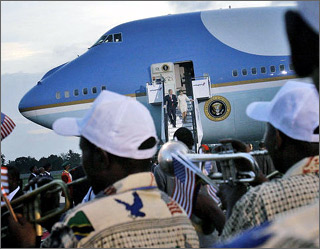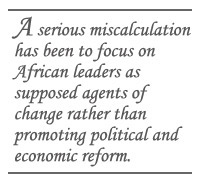Bush in Africa: A Continent Adrift
Bush in Africa: A Continent Adrift

buffeted by disease, hunger and turmoil
NEW YORK: The long-awaited Africa visit by President Bush may disappoint many, as the president steers clear of the continent’s problem areas. But this should not come as a surprise. The modernizing African nations that Washington once counted on as “regional anchors” to serve as engines of growth and sources of stability have themselves emerged as destabilizers.
In 1995 as the president’s special assistant for Africa, I argued that the two dominant prisms through which the US had long viewed the continent – Cold War competition for client states and the anti-apartheid movement in South Africa – had been shattered, and we could adopt a clearer vision for the continent. I suggested Nigeria, Côte d’Ivoire, Zimbabwe, Ethiopia and Kenya as anchors for the promotion of democracy, good governance, poverty reduction, military demobilization, debt relief and improvements in health, education and other social indicators.

With large populations, vibrant economies, democratizing regimes, and internal stability, these countries could serve as entrepots, sources of energy and transport infrastructures, channels of trade and investment, sources of negotiators and peacekeeping forces, models of proper behavior, and havens for refugees.
In light of recent developments, it’s no surprise that the crisis-averse president is not visiting any of these countries.
● In Nigeria, the promise of civilian rule after General Sani Abacha’s death has given way to instability caused by another flawed election, unrest and inequality in the oil-rich Delta region, rampant corruption and a lingering legacy of ethnic division.
● The hopeful outlook for Côte d’Ivoire after Félix Houphouët-Boigny yielded to growing north/south and ethnic tensions, erupting into civil war that required international mediation and thousands of foreign peacekeepers.
● Zimbabwe’s successful transition from Ian Smith’s racist regime is a distant memory as the current regime has essentially declared war against its own population, spreading millions of refugees throughout Southern Africa.
● Ethiopia and its brothers in Eritrea, having thrown off the yoke of Mengistu Haile Mariam, turned on one another in a senseless and brutal boundary war and engaging in destabilizing proxy wars throughout the Horn of Africa, engulfing most notably Somalia in its fire.
● And now Kenya, seemingly the most stable of the regional anchors, is engulfed in a post-electoral dispute that has unleashed latent ethnic, class and regional divides.
Havens of regional stability have themselves become destabilizers. While internal factors largely caused these misfortunes, the international community, including the US, deserves blame as well.

A serious miscalculation has been to focus on African leaders as supposed agents of change rather than promoting political and economic reform. While outwardly rejecting the “Big Men” era in Africa, the US in particular stood behind leaders we believed were the forbearers of an African Renaissance. The period of infatuation differs from country to country, but applies to past visions of Mugabe in Zimbabwe, Bédié in Côte d’Ivoire, Meles in Ethiopia, Obasanjo in Nigeria and Kibaki in Kenya. We persuaded ourselves that they were reformers whose interest in democracy, transparency, social transformation and equality mirrored our own.
Subsequently, President Bush made the “war on terror” our dominant foreign policy theme after September 11, 2001, which harmed American engagement in Africa in two ways:
First, it diverted attention, financial resources and military engagement from the continent and toward other priorities, especially the war in Iraq. While paying welcome attention to fighting HIV/AIDS and expanding trade with Africa, the Bush administration responded tepidly or not at all to the evisceration of democracy, good governance and social services in these anchors.

Second, Bush generally supported existing leaders who were smart enough to proclaim themselves “allies” in the fight against Al Qaeda and other terrorists – similar to the professions of anti-Communism that emanated from cynical African leaders during the Cold War – often through military aid that strengthened repressive regimes. The US has supported so-called anti-terrorist campaigns, such as the ill-advised Ethiopian invasion of Somalia in 2006-2007, no matter the consequences for regional stability, refugee flows and humanitarian impact.
These considerations weigh heavily in Kenya, where American support for President Mwai Kibaki blinded the US to impending tragedy. The announcement last December that Kibaki won the presidential elections plunged the country into unprecedented political, security and humanitarian crisis. Six weeks later, protest riots, repression by security forces and revenge killings have caused more than 1000 deaths and displaced 300,000 or more people. Beyond the loss of life, Kenya’s economy had lost about $1.5 billion by early February. The country remains tense and volatile.
The violence shattered Kenya’s reputation as a haven of stability. Images of Kisumu city center burned to the ground, Nairobi and Mombasa slums on fire, and a church with 30 people inside torched by vigilantes in the Rift Valley illustrated the fragility of the national fabric. Beneath the surface of Kibaki’s pro-Western, anti-terrorist rhetoric is the reality of a country with a gaping disparity between the rich and the poor, where land distribution is lopsided, where politics have been turned ethnic, and where the wounds created by Daniel Arap Moi’s divide-and-rule policies during the 1990s remain open. Although calm has partially returned, this political battle could easily spiral into renewed large-scale violence, which already took a dangerous ethnic turn. Reports of militia mobilizing and arming on both sides have been confirmed.
Kenya long accepted refugees from neighboring conflicts in Somalia and Ethiopia; provided transport links for Uganda, Rwanda, eastern Congo and southern Sudan; hosted regional peace talks; and served as a conduit for investment throughout the Horn of Africa. Now it cannot now perform these tasks. In effect, the doctor has become the patient.
Immediate goals for the mediation team led by former UN Secretary-General Kofi Annan are to end the violence, address the humanitarian crisis, resettle displaced persons, and resolve the electoral crisis. But stopping there would represent another attempt at a quick-fix solution that would repeat the mistakes of the past in the regional anchors.
A legitimately elected government should remain the goal, along with fundamental institutional and economic reforms and an internationally monitored transitional justice and disarmament process to help heal the wounds of two decades of inter-ethnic violence and prevent its resumption.

The international mediation should pursue a settlement that includes, among others steps, the launching of an internationally supported review of electoral procedures to ensure that fraud does not recur and that the Kenyan judiciary can adjudicate disputes; a transition period to restore democratic governance, including a power-sharing deal among parties and constitutional reform; an agreement on transition policies with respect to economic reforms, resettlement of the displaced and settlement of land grievances; establishment of an independent commission to address ethnic violence, ensure accountability for crimes committed in the post-election violence, and guarantee security for all ethnic groups; and establishment of a process to disarm and dismantle party-supported militias.
These steps to create responsive and transparent government, address tragic social inequalities, and mend class, ethnic and regional divisions are essentially the same measures required in the other so-called African anchors. Clear-minded international attention to these challenges – supported by appropriate incentives, sanctions and support – can ensure that these regional anchors not only secure themselves, but buoy the efforts to revitalize Africa.
Donald Steinberg is deputy president for policy at International Crisis Group. He previously served as President Clinton’s special assistant for African Affairs and American ambassador to Angola.